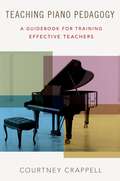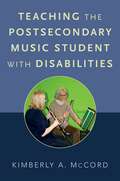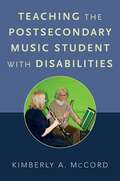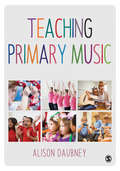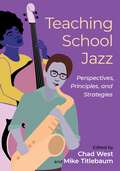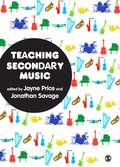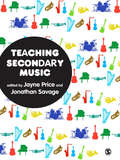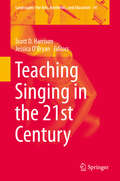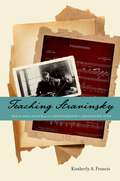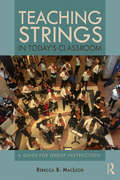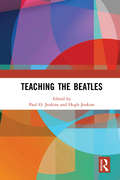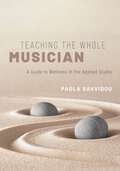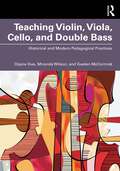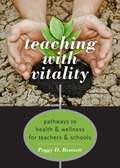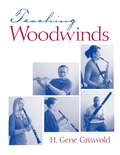- Table View
- List View
Teaching Piano Pedagogy: A Guidebook for Training Effective Teachers
by Courtney CrappellProviding essential tools to transform college piano students into professional piano teachers, Courtney Crappell's Teaching Piano Pedagogy helps teachers develop pedagogy course curricula, design and facilitate practicum-teaching experiences, and guide research projects in piano pedagogy. The book grounds the reader in the history of the domain, investigates course materials, and explores unique methods to introduce students to course concepts and help them put those concepts into practice. To facilitate easy integration into the curriculum, Crappell provides example classroom exercises and assignments throughout the text, which are designed to help students understand and practice the related topics and skills. Teaching Piano Pedagogy is not simply a book about teaching piano--it is a book about how piano students learn to teach.
TEACHING PIANO PEDAGOGY C: A Guidebook for Training Effective Teachers
by Courtney CrappellProviding essential tools to transform college piano students into professional piano teachers, Courtney Crappell's Teaching Piano Pedagogy helps teachers develop pedagogy course curricula, design and facilitate practicum-teaching experiences, and guide research projects in piano pedagogy. The book grounds the reader in the history of the domain, investigates course materials, and explores unique methods to introduce students to course concepts and help them put those concepts into practice. To facilitate easy integration into the curriculum, Crappell provides example classroom exercises and assignments throughout the text, which are designed to help students understand and practice the related topics and skills. Teaching Piano Pedagogy is not simply a book about teaching piano--it is a book about how piano students learn to teach.
TEACHING POSTSEC MUS STUD WITH DISABIL C
by Kimberly A. McCordTeaching the Postsecondary Music Student with Disabilities provides valuable information and practical strategies for teaching the college music student. With rising numbers of students with disabilities in university music schools, professors are being asked to accommodate students in their studios, classes, and ensembles. Most professors have little training or experience in teaching students with disabilities. This book provides a resource for creating an inclusive music education for students who audition and enter music school. Teaching the Postsecondary Music Student with Disabilities covers all of the topics that all readers need to know including law, assistive technology, high-incidence and low-incidence disabilities, providing specific details on the disability and how it impacts the learning of the music student.
Teaching Primary Music (PDF)
by Dr Alison DaubneyHigh quality music education can start children on a journey that lasts a lifetime. This book gives beginning primary school teachers clear guidance on how to successfully teach music without recourse to specialised training. It places music within the wider context of the primary curriculum with clear links to the new National Curriculum in England. It also offers advice on how to provide evidence for and assess musical development and how to plan for music education across the EYFS and key stages 1 & 2. Useful information on using the musical resources in your local community to enhance the opportunities offered to your school is also provided. This is essential reading for all students studying primary music on initial teacher education courses, including undergraduate (BEd, BA with QTS), postgraduate (PGCE, School Direct, SCITT), and also NQTs. Alison Daubney is a music educator, researcher and curriculum adviser at the University of Sussex.
Teaching School Jazz: Perspectives, Principles, and Strategies
Written by an experienced and diverse lineup of veteran jazz educators, Teaching School Jazz presents a comprehensive approach to teaching beginning through high school-level jazz. Thoroughly grounded in the latest research, chapters are supported by case studies woven into the narrative. The book therefore provides not only a wealth of school jazz teaching strategies but also the perspectives and principles from which they are derived. The book opens with a philosophical foundation to describe the current landscape of school jazz education. Readers are introduced to two expert school jazz educators who offer differing perspectives on the subject. The book concludes with an appendix of recommended audio, visual, digital, and written resources for teaching jazz. Accompanied by a website of playing exercises and audio examples, the book is invaluable resource for pre- and in-service music educators with no prior jazz experience, as well as those who wish to expand their knowledge of jazz performance practice and pedagogy.
TEACHING SCHOOL JAZZ C: Perspectives, Principles, and Strategies
by Chad West and Mike TitlebaumWritten by an experienced and diverse lineup of veteran jazz educators, Teaching School Jazz presents a comprehensive approach to teaching beginning through high school-level jazz. Thoroughly grounded in the latest research, chapters are supported by case studies woven into the narrative. The book therefore provides not only a wealth of school jazz teaching strategies but also the perspectives and principles from which they are derived. The book opens with a philosophical foundation to describe the current landscape of school jazz education. Readers are introduced to two expert school jazz educators who offer differing perspectives on the subject. The book concludes with an appendix of recommended audio, visual, digital, and written resources for teaching jazz. Accompanied by a website of playing exercises and audio examples, the book is invaluable resource for pre- and in-service music educators with no prior jazz experience, as well as those who wish to expand their knowledge of jazz performance practice and pedagogy.
Teaching Secondary Music
by Jayne Price Jonathan SavageDesigned to support teachers in developing new strategies and pedagogies for teaching music, and for teacher education students requiring a comprehensive overview of the subject Teaching Secondary Music provides a modern and accessible insight into the key issues in music education at secondary level. Focusing on the nature of musical understanding and how to facilitate and assess musical progress, the editors bring together a team of experienced music educators leading the programme of support for the new secondary curriculum. Supported with practical examples, case studies and resources exploring effective practice, Teaching Secondary Music covers the key concepts and approaches which underpin good practice in secondary music education. These include: -How music relates to other curriculum subjects -Ways of implementing newer aspects of the curriculum -The music industry and intellectual property rights -Working with a range of musicians -Using ICT as a tool for musical performance -Developing musical leadership This book is essential reading for PGCE Secondary music specialists and practising music teachers. Jayne Price is the Music Education Coordinator in the School of Education and Professional Development at the University of Huddersfield. Jonathan Savage is a Reader in Education at the Institute of Education, Manchester Metropolitan University.
Teaching Secondary Music
by Jayne Price Jonathan SavageDesigned to support teachers in developing new strategies and pedagogies for teaching music, and for teacher education students requiring a comprehensive overview of the subject Teaching Secondary Music provides a modern and accessible insight into the key issues in music education at secondary level. Focusing on the nature of musical understanding and how to facilitate and assess musical progress, the editors bring together a team of experienced music educators leading the programme of support for the new secondary curriculum. Supported with practical examples, case studies and resources exploring effective practice, Teaching Secondary Music covers the key concepts and approaches which underpin good practice in secondary music education. These include: -How music relates to other curriculum subjects -Ways of implementing newer aspects of the curriculum -The music industry and intellectual property rights -Working with a range of musicians -Using ICT as a tool for musical performance -Developing musical leadership This book is essential reading for PGCE Secondary music specialists and practising music teachers. Jayne Price is the Music Education Coordinator in the School of Education and Professional Development at the University of Huddersfield. Jonathan Savage is a Reader in Education at the Institute of Education, Manchester Metropolitan University.
Teaching Singing in the 21st Century (Landscapes: the Arts, Aesthetics, and Education #14)
by Scott D. Harrison Jessica O'BryanThis volume brings together a group of leading international researchers and practitioners in voice pedagogy alongside emerging academics and practitioners. Encompassing research across voice science and pedagogy, this innovative collection transcends genre boundaries and provides new knowledge about vocal styles and approaches from classical and musical theatre to contemporary commercial music. The work is sure to be valuable in tertiary institutions, schools and community music associations, suitable for use by private studio teachers, and will appeal to choral leaders and music educators interested in vocal pedagogy. “I thoroughly enjoyed reading this book and I am confident it will help bring all aspects of vocal pedagogy firmly into the 21st century. Refreshingly, many different areas of pedagogy are included in the text so we can all work together to more fully understand the singing voice. Up to the moment research is included along with an exploration of the evolving contemporary styles of singing. Further, areas regarding teaching and curriculum in higher education are also reviewed. All in all, this text a crucial addition to a professional's vocal library.” Jeanne Goffi-Fynn, Teachers College, Columbia University, USA.
Teaching Stravinsky: Nadia Boulanger and the Consecration of a Modernist Icon
by Kimberly A. FrancisIn 1929 Nadia Boulanger accepted Igor Stravinsky's younger son, Soulima, as her student. Within two years, Stravinsky and Boulanger merged their artistic spheres, each influencing and enhancing the cultural work of the other until the composer's death in 1971. Teaching Stravinsky tells Boulanger's story of the ever-changing nature of her fractious relationship with Stravinksy. Author Kimberly A. Francis explores how Boulanger's own professional activity during the turbulent twentieth-century intersected with her efforts on behalf of Stravinsky, and how this facilitated her own influential conversations with the composer about his works while also drawing her into close contact with his family. Through the theoretical lens of Bourdieu, and drawing upon over one thousand pages of letters and scores, many published here for the first time, Francis examines the extent to which Boulanger played a foundational role in defining, defending, and ultimately consecrating Stravinsky's canonical identity. She considers how the quotidian events in the lives of these two icons of modernism informed both their art and their professional decisions, and convincingly argues for a reevaluation of the influence of women on cultural production during the twentieth century. At once a story of one woman's vibrant friendship with an iconic modernist composer, and a case study in how gendered polemics informed professional negotiations of the artistic-political fields of the twentieth-century, Teaching Stravinsky sheds new light not only on how Boulanger taught Stravinsky, but also how, in doing so, she managed to influence the course of modernism itself.
Teaching Stravinsky: Nadia Boulanger and the Consecration of a Modernist Icon
by Kimberly A. FrancisIn 1929 Nadia Boulanger accepted Igor Stravinsky's younger son, Soulima, as her student. Within two years, Stravinsky and Boulanger merged their artistic spheres, each influencing and enhancing the cultural work of the other until the composer's death in 1971. Teaching Stravinsky tells Boulanger's story of the ever-changing nature of her fractious relationship with Stravinksy. Author Kimberly A. Francis explores how Boulanger's own professional activity during the turbulent twentieth-century intersected with her efforts on behalf of Stravinsky, and how this facilitated her own influential conversations with the composer about his works while also drawing her into close contact with his family. Through the theoretical lens of Bourdieu, and drawing upon over one thousand pages of letters and scores, many published here for the first time, Francis examines the extent to which Boulanger played a foundational role in defining, defending, and ultimately consecrating Stravinsky's canonical identity. She considers how the quotidian events in the lives of these two icons of modernism informed both their art and their professional decisions, and convincingly argues for a reevaluation of the influence of women on cultural production during the twentieth century. At once a story of one woman's vibrant friendship with an iconic modernist composer, and a case study in how gendered polemics informed professional negotiations of the artistic-political fields of the twentieth-century, Teaching Stravinsky sheds new light not only on how Boulanger taught Stravinsky, but also how, in doing so, she managed to influence the course of modernism itself.
Teaching Strings in Today's Classroom: A Guide for Group Instruction
by Rebecca B. MacLeodTeaching Strings in Today’s Classroom: A Guide for Group Instruction assists music education students, in-service teachers, and performers to realize their goals of becoming effective string educators. It introduces readers to the school orchestra environment, presents the foundational concepts needed to teach strings, and provides opportunities for the reader to apply this information. The author describes how becoming an effective string teacher requires three things of equal importance: content knowledge, performance skills, and opportunities to apply the content knowledge and performance skills in a teaching situation. In two parts, the text addresses the unique context that is teaching strings, a practice with its own objectives and related teaching strategies. Part I (Foundations of Teaching and Learning String Instruments) first presents an overview of the string teaching environment, encouraging the reader to consider how context impacts teaching, followed by practical discussions of instrument sizing and position, chapters on the development of each hand, and instruction for best practices concerning tone production, articulation, and bowing guidelines. Part II (Understanding Fingerings) provides clear guidance for understanding basic finger patterns, positions, and the creation of logical fingerings. String fingerings are abstract and thus difficult to negotiate without years of playing experience—these chapters (and their corresponding interactive online tutorials) distill the content knowledge required to understand string fingerings in a way that non-string players can understand and use. Teaching Strings in Today’s Classroom contains pedagogical information, performance activities, and an online virtual teaching environment with twelve interactive tutorials, three for each of the four string instruments.
Teaching Strings in Today's Classroom: A Guide for Group Instruction
by Rebecca B. MacLeodTeaching Strings in Today’s Classroom: A Guide for Group Instruction assists music education students, in-service teachers, and performers to realize their goals of becoming effective string educators. It introduces readers to the school orchestra environment, presents the foundational concepts needed to teach strings, and provides opportunities for the reader to apply this information. The author describes how becoming an effective string teacher requires three things of equal importance: content knowledge, performance skills, and opportunities to apply the content knowledge and performance skills in a teaching situation. In two parts, the text addresses the unique context that is teaching strings, a practice with its own objectives and related teaching strategies. Part I (Foundations of Teaching and Learning String Instruments) first presents an overview of the string teaching environment, encouraging the reader to consider how context impacts teaching, followed by practical discussions of instrument sizing and position, chapters on the development of each hand, and instruction for best practices concerning tone production, articulation, and bowing guidelines. Part II (Understanding Fingerings) provides clear guidance for understanding basic finger patterns, positions, and the creation of logical fingerings. String fingerings are abstract and thus difficult to negotiate without years of playing experience—these chapters (and their corresponding interactive online tutorials) distill the content knowledge required to understand string fingerings in a way that non-string players can understand and use. Teaching Strings in Today’s Classroom contains pedagogical information, performance activities, and an online virtual teaching environment with twelve interactive tutorials, three for each of the four string instruments. ACCOMPANYING VIDEOS CAN BE ACCESSED VIA THE AUTHOR'S WEBSITE: www.teachingstrings.online
Teaching the Beatles
by Paul O. Jenkins Hugh JenkinsTeaching the Beatles is designed to provide ideas for instructors who teach the music of the Beatles. Experienced contributors describe varied approaches to effectively convey the group’s characteristics and lasting importance. Some of these include: treating the Beatles’ lyrics as poetry; their influence on the world of art, film, fashion and spirituality; the group’s impact on post-war Britain; political aspects of the Fab Four; Lennon and McCartney’s songwriting and musical innovations; the band’s use of recording technology; business aspects of the Beatles’ career; and insights into teaching the Beatles in an online format.
Teaching the Beatles
by Paul O. Jenkins and Hugh JenkinsTeaching the Beatles is designed to provide ideas for instructors who teach the music of the Beatles. Experienced contributors describe varied approaches to effectively convey the group’s characteristics and lasting importance. Some of these include: treating the Beatles’ lyrics as poetry; their influence on the world of art, film, fashion and spirituality; the group’s impact on post-war Britain; political aspects of the Fab Four; Lennon and McCartney’s songwriting and musical innovations; the band’s use of recording technology; business aspects of the Beatles’ career; and insights into teaching the Beatles in an online format.
Teaching the Postsecondary Music Student with Disabilities
by Kimberly A. McCordTeaching the Postsecondary Music Student with Disabilities provides valuable information and practical strategies for teaching the college music student. With rising numbers of students with disabilities in university music schools, professors are being asked to accommodate students in their studios, classes, and ensembles. Most professors have little training or experience in teaching students with disabilities. This book provides a resource for creating an inclusive music education for students who audition and enter music school. Teaching the Postsecondary Music Student with Disabilities covers all of the topics that all readers need to know including law, assistive technology, high-incidence and low-incidence disabilities, providing specific details on the disability and how it impacts the learning of the music student.
Teaching the Whole Musician: A Guide to Wellness in the Applied Studio
by Paola SavvidouIn Teaching the Whole Musician: A Guide to Wellness in the Applied Studio, author Paola Savvidou empowers applied music instructors to honor and support their students' wellness through compassion-filled conversation tools, hands-on activities for injury prevention, mental health protection, and recovery support. Many music students are facing devastating injuries and emotional peril as they navigate the transition from student to professional. Experts are sounding the alarm for the need to educate students on the negative effects of habits such as postural misalignments, sleep deprivation, and over exertion. In this book, music teachers will learn how to help students develop skills and learn behaviors that will expand their self-awareness as they work towards a fulfilled career in the arts. With a wealth of additional movement experiences, audio files, and downloadable worksheets, the instructor can easily share movement exercises, nutrition diaries, and meditations with their students. The first guidebook of its kind to address wellness for music students in a comprehensive manner geared towards the applied instructor, this volume provides simple yet impactful techniques for approaching all things wellness.
Teaching the Whole Musician: A Guide to Wellness in the Applied Studio
by Paola SavvidouIn Teaching the Whole Musician: A Guide to Wellness in the Applied Studio, author Paola Savvidou empowers applied music instructors to honor and support their students' wellness through compassion-filled conversation tools, hands-on activities for injury prevention, mental health protection, and recovery support. Many music students are facing devastating injuries and emotional peril as they navigate the transition from student to professional. Experts are sounding the alarm for the need to educate students on the negative effects of habits such as postural misalignments, sleep deprivation, and over exertion. In this book, music teachers will learn how to help students develop skills and learn behaviors that will expand their self-awareness as they work towards a fulfilled career in the arts. With a wealth of additional movement experiences, audio files, and downloadable worksheets, the instructor can easily share movement exercises, nutrition diaries, and meditations with their students. The first guidebook of its kind to address wellness for music students in a comprehensive manner geared towards the applied instructor, this volume provides simple yet impactful techniques for approaching all things wellness.
Teaching Violin, Viola, Cello, and Double Bass: Historical and Modern Pedagogical Practices
by Dijana Ihas Miranda Wilson Gaelen McCormickTeaching Violin, Viola, Cello, and Double Bass summarizes three centuries of string pedagogy treatises to create a comprehensive resource on methods and approaches to teaching all four bowed string instruments. Co-written by three performance and pedagogy experts, each specializing in different string instruments, this book is applicable to all levels of instruction.Essays on historical pedagogues are clearly structured to allow for easy comprehension of their philosophies, pedagogical practices, and unique contributions. This book concludes with a section on application through comparative analysis of the historical methods and approaches.With coverage from the eighteenth century to the present, this book will be invaluable for teachers and students of string pedagogy and general readers who wish to learn more about string pedagogy’s rich history, diverse content, and modern developments.
Teaching Violin, Viola, Cello, and Double Bass: Historical and Modern Pedagogical Practices
by Dijana Ihas Miranda Wilson Gaelen McCormickTeaching Violin, Viola, Cello, and Double Bass summarizes three centuries of string pedagogy treatises to create a comprehensive resource on methods and approaches to teaching all four bowed string instruments. Co-written by three performance and pedagogy experts, each specializing in different string instruments, this book is applicable to all levels of instruction.Essays on historical pedagogues are clearly structured to allow for easy comprehension of their philosophies, pedagogical practices, and unique contributions. This book concludes with a section on application through comparative analysis of the historical methods and approaches.With coverage from the eighteenth century to the present, this book will be invaluable for teachers and students of string pedagogy and general readers who wish to learn more about string pedagogy’s rich history, diverse content, and modern developments.
Teaching with Vitality: Pathways to Health and Wellness for Teachers and Schools
by Peggy D. BennettPerhaps more than any other experience, conflict in schools and workplaces can zap our energy and steal our vigor as teachers. If we knew ways to minimize conflict and maximize vitality, would we use them? Teaching with Vitality offers specific behaviors and attitudes to reframe conflict by diluting and dissolving it. Organized into brief topics for busy readers, Teaching with Vitality combines common experiences and practical options for lessening the turmoil that is inevitable in schools. As beneficent stewards of our children, educators are priceless contributors to the quality of our lives. The main goal of Teaching with Vitality is to elevate teachers in their day-to-day lives by deconstructing the major and minor conflicts that sap their peace and dampen their power. School wellness is contagious. And, this book aims to offer daily pathways to health, wellness, and vigor.
Teaching with Vitality: Pathways to Health and Wellness for Teachers and Schools
by Peggy D. BennettPerhaps more than any other experience, conflict in schools and workplaces can zap our energy and steal our vigor as teachers. If we knew ways to minimize conflict and maximize vitality, would we use them? Teaching with Vitality offers specific behaviors and attitudes to reframe conflict by diluting and dissolving it. Organized into brief topics for busy readers, Teaching with Vitality combines common experiences and practical options for lessening the turmoil that is inevitable in schools. As beneficent stewards of our children, educators are priceless contributors to the quality of our lives. The main goal of Teaching with Vitality is to elevate teachers in their day-to-day lives by deconstructing the major and minor conflicts that sap their peace and dampen their power. School wellness is contagious. And, this book aims to offer daily pathways to health, wellness, and vigor.
Teaching Woodwinds
by Harold Gene GriswoldFor one semester/quarter courses in woodwind methods. Teaching Woodwinds has draws on the authors thirty-five years of experience teaching woodwinds to students. Organized by specific teach topics from the fundamentals of hand and finger position to articulation and intonation. Drawing on a classic set of teacher/student duets, the included twenty-five class lessons enable students to learn by doing and by listening as they play duets with the instructor.
Teaching Woodwinds
by Harold Gene GriswoldFor one semester/quarter courses in woodwind methods. Teaching Woodwinds has draws on the authors thirty-five years of experience teaching woodwinds to students. Organized by specific teach topics from the fundamentals of hand and finger position to articulation and intonation. Drawing on a classic set of teacher/student duets, the included twenty-five class lessons enable students to learn by doing and by listening as they play duets with the instructor.
